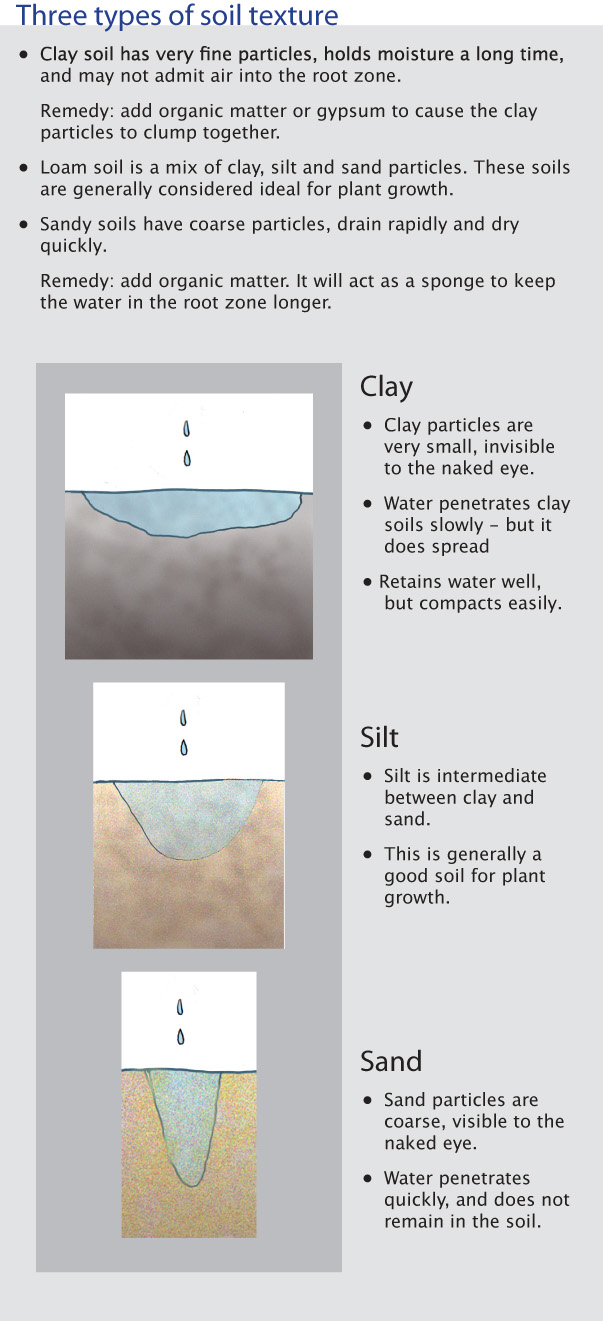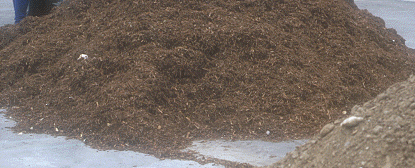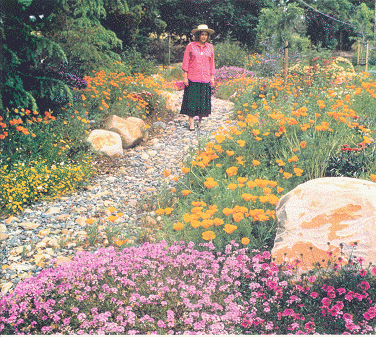- TABLE OF CONTENTS
- REDUCE YOUR WATER NEEDS
- Use Drought Tolerant Plants
- California Native Plants
- Climate Zones
- Reduce or Replace Lawn
- Artificial Turf
- IRRIGATE EFFICIENTLY
- Water Needs of Plants
- Before You Design
- Types of Irrigation Systems
- Weather Based Irrigation Controllers
- Working with an Irrigation Contractor
- DEVELOP ALTERNATE SOURCES OF WATER
- RETAIN WATER IN THE LANDSCAPE
- Build Retaining Walls
- Mulch to Reduce Evaporation
- Install Permeable Hardscapes
- Amend Soil with Organic Materials
- KEEP YOUR WATER PURE
- Drainage
- Eliminate Runoff and Overspray
- Slow it, Spread it, Sink it
- Ocean Friendly Gardens
- Rain Gardens
- Swales
- Keep Your Watershed Beautiful
- Soil
- Pests
- Select Plants that Don't Need Chemicals
- ADDITIONAL GARDENING RESOURCES
Soil
The quality of your soil depends upon the history of the land use and the extent to which the soil has been manipulated by developers and/or homeowners.
The individual actions that each of us takes - how we dig in the soil, what we put on or add into it will influence the quality and integrity of the soil.
Be familiar with your soil. Start with a basic test and analysis that will reveal nutrient deficiencies and the soil’s pH. Test kits sold at your local nursery will give an indication of your soil’s condition. For a more precise reading, have the test done at a laboratory. Look on the Internet or in the Yellow Pages under "Laboratories – Analytical." The lab will advise as to where and how to collect the soil samples to test.
Garden Soil
Think of soil as a sponge with pore space containing water, air, mineral particles, and living and dead organic matter. A good garden soil has uniform texture, neutral pH, and the ability to hold water for root nourishment (water-holding capacity) while allowing excess water to drain (soil permeability).
 |
Soil pH
Soil with a pH of 7 is neutral (neither acid nor alkaline). A pH below 7 is acid, and above 7 is alkaline. Test your soil to determine its pH. Suggestions for correcting soil pH:
Add lime (calcium carbonate) to acid soil to raise the pH (you can use your test lab application rates as a guideline). Acid soil is most common in areas of heavy rainfall, sandy soils, and high organic matter.
Add sulfur to lower pH. Alkaline soil is high in calcium carbonate. Clay soil tends to be alkaline.
Soil Type
What type of soil do you have?
Drench a patch of soil and let it dry out for a day. Pick up a handful and squeeze it firmly. If it forms a tight ball and has a slippery feel, it’s clay; gritty and doesn’t hold its shape (crumbles apart when you open your hand), it’s sandy; slightly crumbly but still holds a loose ball, it’s closer to loam.

Clay, sand, and loam make up the three soil types. Clay has small, thin, disk-shaped particles. Sand has large, rounded particles mixed with medium sized silt particles. Loam is a mix of clay, silt, and sand. It is the ideal garden soil. The combination of large and small pores allows good drainage and enough air space for healthy root growth with only a moderate loss of nutrients.
Improving Your Soil
Clay soils are common in many areas. It has little pore space for roots, poor-to-no drainage, and compacts too easily, causing less and less room for root growth.
Improve soil structure by following these steps:
Work in plenty of organic matter to improve drainage.
Allow time between watering so air can return to the root zone.
Create raised beds and fill with garden soil mix.
 |
If this procedure fails to improve the structure of the clay soil, you may need to install a subsurface drain system to carry away excess groundwater. Commonly known as a French drain, the system consists of lengths of perforated drainpipe installed in a gravel-filled trench set at a slight downward slope to facilitate drainage. Wrap the pipe with filter fabric prior to installing it in the gravel. If the perforated holes are only on one side of the pipe, be sure to position the holes facing down toward the bottom of the trench.
 |
Hardpan
A hardpan soil layer causes gardeners much grief. Hardpan is created when builders spread excavated subsoil over the soil surface and repeatedly drive heavy equipment over it. Top layers of hardpan may be broken and the soil improved by the following:
Till the soil to a depth of 1 foot or more.
If tilling is not possible, drill through the hardpan with a soil auger to the porous soil below.
A hardpan layer may require the installation of a French drain.
Use raised beds in the garden and fill with garden soil mix.
Sandy soil usually drains quickly causing an increased loss of nutrients.
Planting in this type of soil may require more frequent watering than the other soils.
Add organic amendments to improve sandy soil.
Organic Matter
Organic matter, often referred to as amendment, is vital to soil fertility. It is especially necessary for clay and sandy soils. Be sure to add organic matter/amendment to your soil; it releases nutrients as it decomposes into humus. There are many types available:
-
Compost - is the best form of organic matter. Municipal compost, homemade compost and mushroom compost are excellent amendments. Visit www.compostsantacruzcounty.org/index.htm for more information on composting procedures.
-
Manure - contains more nutrients than most other organic matter. Age manure avoids adding excess salts to the soil.
-
Peat moss - increases acidity and is used in soils for acid-loving plants.
-
Sawdust, wood shavings, and ground bark – high carbon organic matter that may require the addition of nitrogen before use.
-
Redwood soil conditioner - made from the bark and sawdust of redwood trees. Already fortified with nitrogen, it is a commonly used organic matter.
To prepare a plant bed, spread a 3 to 4 inch layer of organic matter/amendment over the soil and dig or till into the top 9 to 12 inches for optimum plant growth. Be generous when adding organic amendments.